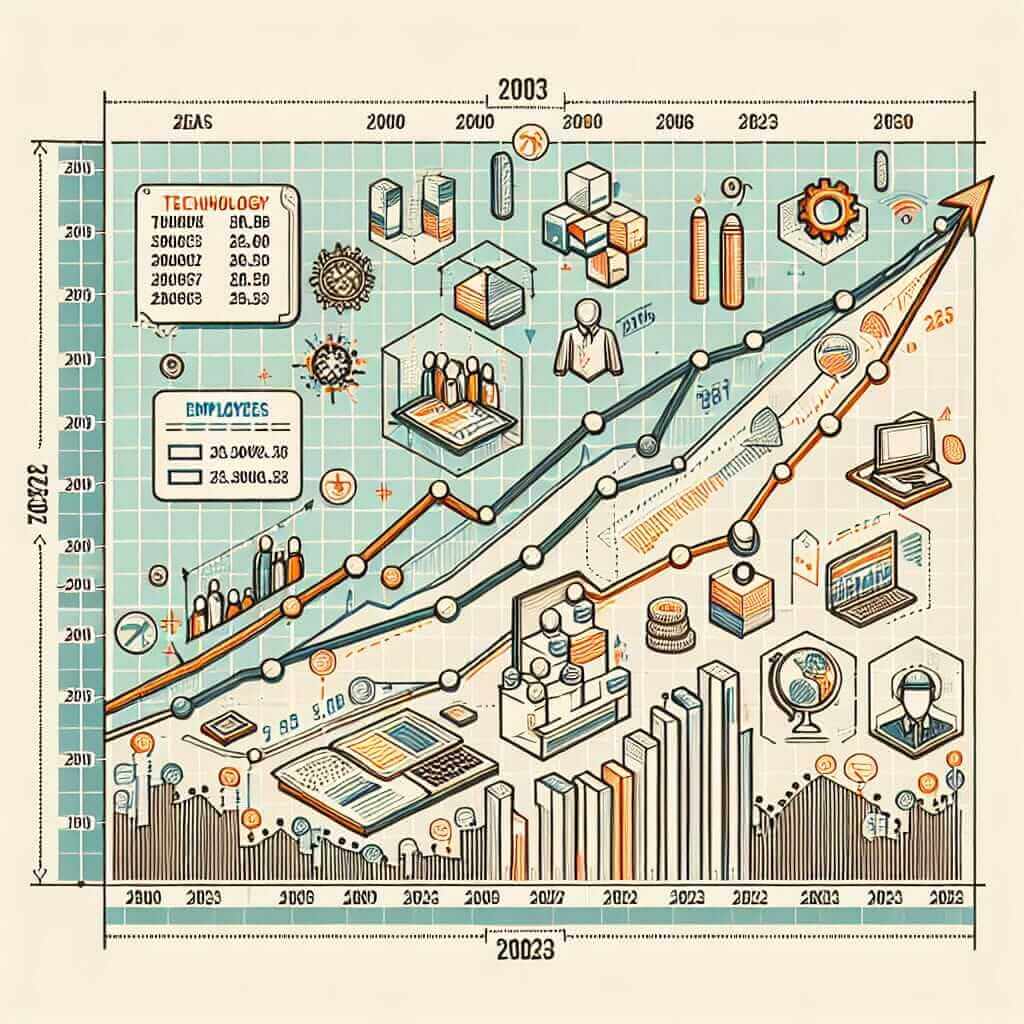The topic of employment trends in various sectors, especially comparing technology vs. non-technology sectors, is a significant one in the IELTS Writing task 1. This type of question often appears, where you have to analyze a chart, table, or graph showing employment data over a period of time. In this guide, we will delve into this type of question comprehensively, providing insights into grammar, vocabulary, and effective strategies for writing a high-scoring response.
Introduction to the Topic
The topic of “Employment in Technology vs Non-Technology Sectors (2000-2023)” explores the changes in employment rates within these two sectors over a specified period. This comparison can reveal crucial trends and insights regarding economic shifts, technological advancements, and their impact on job markets.
Sample Essay Topics
- The provided line graph shows the number of employees in technology and non-technology sectors from 2000 to 2023. Summarize the information by selecting and reporting the main features, and make comparisons where relevant.
- Compare the employment trend data for technology and non-technology sectors from 2000 to 2023 provided in the bar chart. Summarize the information by selecting and reporting the main features.
- The table below displays the employment figures for technology and non-technology sectors from 2000 to 2023. Summarize the information and make comparisons where relevant.
Sample Essay
Data Analysis and Visualization
Let’s assume we’re working with the following data represented in a line graph format:
| Year | Technology Sector Employment (in thousands) | Non-Technology Sector Employment (in thousands) |
|---|---|---|
| 2000 | 150 | 500 |
| 2005 | 300 | 450 |
| 2010 | 600 | 400 |
| 2015 | 900 | 380 |
| 2020 | 1200 | 350 |
| 2023 | 1400 | 300 |

Analysis of the Data
First, it’s crucial to identify key trends:
- Technology Sector: A steadily increasing trend is observed, with employment numbers rising from 150,000 in 2000 to 1,400,000 in 2023.
- Non-Technology Sector: A continuous decline in employment, from 500,000 in 2000 to 300,000 in 2023.
Writing the Essay
Prompt: The provided line graph shows the number of employees in technology and non-technology sectors from 2000 to 2023. Summarize the information by selecting and reporting the main features, and make comparisons where relevant.
Sample Essay:
The line graph illustrates the number of employees in the technology and non-technology sectors from 2000 to 2023. The data indicates a significant divergence in employment trends between these two sectors over the 23-year period.
Overall, the technology sector exhibited a consistent upward trajectory in its employment figures. Starting at 150,000 employees in 2000, the numbers more than quadrupled to 1,400,000 by 2023. Notably, the most substantial increases occurred between 2005 and 2015, with the sector adding 600,000 jobs over this decade.
In contrast, the non-technology sector experienced a gradual decline in employment numbers. From a high of 500,000 employees in 2000, the sector saw a continual decrease, dropping to 300,000 by 2023. This downtrend highlights a substantial loss of 200,000 jobs over the analyzed period.
When comparing the two sectors, it is evident that while the technology sector thrived and expanded, the non-technology sector faced a considerable reduction in its workforce. This divergence suggests a shift in the job market towards technology-oriented roles, potentially driven by advancements in technology and changes in economic demands.
In summary, the data reveals contrasting employment patterns in the technology and non-technology sectors from 2000 to 2023, with the former experiencing considerable growth, whereas the latter declined steadily.
Word count: 215
Key Insights and Tips
Vocabulary and Grammar
Key Vocabulary:
- Trajectory (noun) /trəˈdʒek.tər.i/: the path followed by a process or object.
- Divergence (noun) /daɪˈvɜː.dʒəns/: the process or state of diverging.
- Substantial (adjective) /səbˈstæn.ʃəl/: of considerable importance, size, or worth.
- Quadruple (verb) /ˈkwɒd.ruː.pəl/: to increase fourfold.
- Advancements (noun) /ədˈvɑːns.mənts/: progress or development in a particular area.
Common Structures:
- Overall trend: “Overall, the technology sector exhibited a consistent upward trajectory…”
- Comparison: “When comparing the two sectors, it is evident that…”
- Contrasting data: “In contrast, the non-technology sector experienced a gradual decline…”
Writing Tips
- Understand the Data: Always start by thoroughly analyzing the charts, graphs, or tables provided. Identify main trends, significant changes, and any patterns.
- Use Clear Paragraphing: Structure your essay clearly. Typically, an introduction, a body (with clear separate points), and a conclusion.
- Be Concise and Focused: Stick to key information and avoid unnecessary details. Remember the word limit.
- Linking Words and Phrases: Use appropriate linking words (e.g., “Furthermore”, “In contrast”, “However”) to connect ideas smoothly.
- Precision in Vocabulary: Use specific and varied vocabulary relevant to the topic.
Conclusion
Writing a successful response to an IELTS Writing Task 1 question on employment trends requires a strategic approach. By focusing on clear analysis, structured writing, and appropriate language use, you can craft essays that are both insightful and logically coherent. Practice regularly with different datasets to improve your speed and accuracy, aiming for that Band 7+ score.
Good luck with your studies, and remember, understanding the data and making meaningful comparisons are key to success!